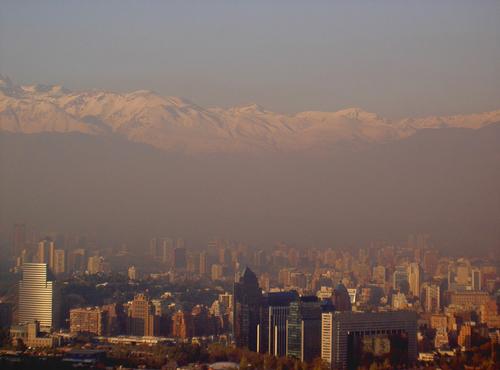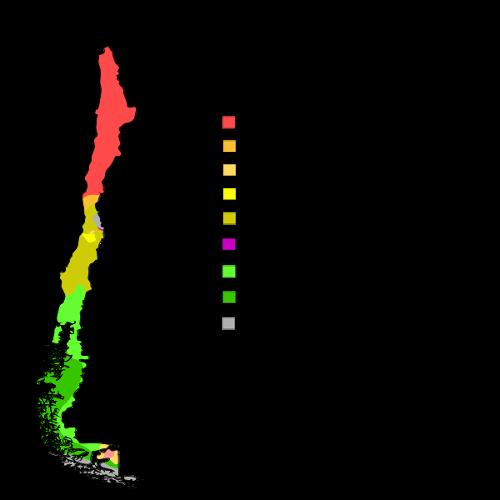CHILE
Climate and Weather

Climate and Weather

Cities in CHILE
| Santiago |
Climate and Weather
 Smog above Santiago ChilePhoto: Michael Ertel CC 3.0 Not Adapted no changes made
Smog above Santiago ChilePhoto: Michael Ertel CC 3.0 Not Adapted no changes made
Chile's climate is defined by the subtropical region of high air pressure over the Pacific Ocean and the associated Peru or Humboldt Current, which carries relatively cold water north along the coast and through the Andes Mountains. Due to the Humboldt Current, temperatures along the west coast of South America are considerably lower than normal at this latitude. The difference with the temperatures on the east coast of the continent is on average 4 to 5 ° C over the year. As a result, the air that flows to the west coast is always cooled by the underlying sea surface and is therefore very stable in structure, so that showers cannot form. This means that little or no precipitation falls at a low latitude.
South of latitude 30 ° south, roughly on the axis of the above-mentioned subtropical high-pressure area, the depressions of moderate latitude can penetrate to the coast of Chile and bring precipitation there, which is further intensified by weirs against the mountain range. Tierra del Fuego is one of the wettest regions in the world.
In the mountains the temperatures decrease with increasing altitude, for the average annual temperature about 0.5 ° C per 100 m. The coastal area in the north of the country has many low clouds, while further south often fog occurs: an average of 50 days a year in Valparaíso and even 90 days in the Gulf of Peñas.
The enormous length of Chile is responsible for many climate zones. The following climate zones can be distinguished from north to south:
 Climate zones of ChilePhoto:Ali Zifan CC 4.0 International no changes made
Climate zones of ChilePhoto:Ali Zifan CC 4.0 International no changes made
Desert climate
Dominates the north of Chile, including the Atacama desert, where rain has never fallen in some places. The coast has a moderate climate; Inland, temperatures exceed 30 °C, but at night it can cool to temperatures around freezing.
High mountain desert climate
The Altiplano predominates, with little rain (50-300 mm per year) and much lower temperatures than in the north. Night frosts can occur all year round.
Semi-desert climate
In the "littke North" with irregular rainy periods. This semi-desert climate changes in some places into a warm steppe climate with rain in the winter months. These are the most pleasant areas to be in.
Mediterranean climate
Dominates central Chile up to the Bío Bío river, with rainy periods only in the cool winters. Summers are hot and dry and behind the coastal mountains near the capital Santiago, temperatures can exceed 35 °C.
Temperate rainy climate
Predominates in the Araucanía and the Lake District, it is a transition area between a Mediterranean and a temperate climate. Only the summer months are dry, the rest of the year it rains a lot. The average temperature in December is a pleasant 23 °C.
Maritime climate
Predominates on the islands along the coast and a zone close to the coast. Sea winds push humid ocean air up against the mountains, causing massive amounts of rainfall all year round, from 2000 to 5000 mm per year.
High mountain climate
Dominates the Patagonian Andes , with lots of storms and snow. In the direction of Tierra del Fuego, the snow line drops to 800 meters!
Continental steppe climate
Predominates on the Patagonian plains, with dry summers and annual rainfall of 200-500 mm. The average annual temperature is only 6-10 ° C.
Easter Island has a subtropical climate with year-round rainfall (approx. 1150 mm), and an average annual temperature of just over 20 °C.
The Juan Fernandez Islands have a Mediterranean climate, with rain especially in winter (approx. 900 mm on an annual basis), and an average annual temperature of 14 °C.
Climate table
| avg. temperature (in °C) | precipitation (in mm) | ||||
| January | july | january | july | yearly | |
| Arica | 22,0 | 15,8 | 1 | 0 | 2 |
| Antofagasta | 20,9 | 14,0 | 0 | 5 | 12 |
| Valparaíso | 17,8 | 11,6 | 0 | 150 | 511 |
| Valdivia | 16,6 | 7,7 | 66 | 448 | 2565 |
| Puerto Montt | 15,3 | 7,7 | 113 | 275 | 2182 |
| Punta Arenas | 11,4 | 2,1 | 19 | 42 | 372 |
Sources
Asal, S. / Chili
Lannoo.
Caistor, N. / Chili : mensen, politiek, economie, cultuur
Koninklijk Instituut voor de Tropen / Novib.
Castillo-Feliú, G.I. / Culture and customs of Chile
Greenwood Press.
Dwyer, C. / Chile
Chelsea House Publishers.
Filippo, H. / Chili
Elmar.
CIA - World Factbook.
BBC - Country Profiles.
Copyright: Team The World of Info